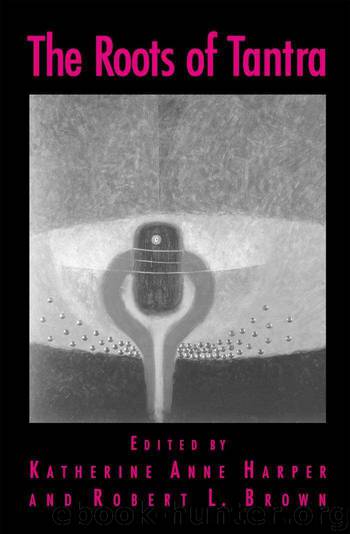The Roots of Tantra by Katherine Anne Harper & Robert L. Brown

Author:Katherine Anne Harper & Robert L. Brown [Harper, Katherine Anne & Brown, Robert L.]
Language: eng
Format: epub
Amazon: B00QJ87FNW
Publisher: SUNY Press
Published: 2012-02-01T18:00:00+00:00
Part IV
THE VEDAS AND TANTRA
9
Imagery of the Self from Veda to Tantra
Teun Goudriaan
Although much time and paper have been spent on discussions of the concept of ātman (hereafter translated as the self) in the Hindu tradition, the intellectual efforts of scholars have not resulted in an explanation of its real nature. Nor could this be expected, since the self, this innermost spiritual core of the person, is held to be beyond the reach of mind or reason. True spirituality cannot be described, only directly experienced in blissful consciousness, such is the prevailing Hindu position.
Indian religious leaders and philosophers themselves had different ideas about the self ’s status, characteristics, stages of development, destination, size, or quantity (unique cosmic ātman or plurality of separate self monads?). Also the terminology is multiform and the mutual distinctions are of a subtle nature and not always clear. To my knowledge, no satisfactory encompassing monograph about the Hindu tradition of the self (in philosophy as well as religion and art) has yet appeared, despite the existence of useful introductory studies such as those by Emil Abegg in 1945 and Troy W. Organ in 1964. Here lies a real challenge, because insight into the self has been expressed to be the real purpose of life,1 the “goal of the internal quest.”2
It is not my intention to add to the existing literature on the philosophical interpretations of the self. Instead, I shall concentrate (on a less technical level) on selected aspects of the verbal imagery by which religious teachers, philosophers and poets have built up a “multiple denomination” in the course of their attempts to give expression to the inexpressible. Surprisingly, these varied approaches to a typology of the self have also not been made the topic of a comprehensive study.
The mystery of the self has been approached and obliquely referred to with remarkable variety and insistence, also with consistence, in Indian literature, in Sanskrit as well as in the rich traditions of the vernaculars. In the following pages, I shall restrict myself to some illustrative examples in Sanskrit literature from the Vedas onward, with special reference to some Upani.sads and early Tantric sources.
The Upani.sads most often referred to are the B.rhadāra.nyaka (B āUp), the Chāndogya (ChUp) and the Maitrāya.nīya (MaiUp), the latter being of a later date than the first two; the Tantric or literature with a Tantric orientation is rather varied, but some emphasis is laid upon the Lak.smī Tantra (LT; Pañcarātra, that is, Vai.s.nava), the Tantrasadbhāva (Tsb; Northern Śaiva), and the Kulālikāmnaya or Kubjikāmata (KMT; Śākta), all three are dated to the early medieval period. An intermediate stage is represented by the Mahābhārata (Mbh). As a deep cleft seems to exist between the findings and the theorizations of modern psychology and the classical Hindu tradition, all attempts at comparison between the two will be avoided at this stage.3 It is also beyond the scope of this paper to try to demonstrate the existence of points of contact in this sphere between the Indian tradition and early Western esotericism.
Download
This site does not store any files on its server. We only index and link to content provided by other sites. Please contact the content providers to delete copyright contents if any and email us, we'll remove relevant links or contents immediately.
Fingersmith by Sarah Waters(2484)
Kundalini by Gopi Krishna(2137)
Wheels of Life by Anodea Judith(2098)
Indian Mythology by Devdutt Pattanaik(1898)
The Bhagavad Gita by Bibek Debroy(1898)
The Yoga of Jesus: Understanding the Hidden Teachings of the Gospels by Paramahansa Yogananda(1804)
Autobiography of a Yogi (Complete Edition) by Yogananda Paramahansa(1774)
The Man from the Egg by Sudha Murty(1743)
The Book of Secrets: 112 Meditations to Discover the Mystery Within by Osho(1630)
Chakra Mantra Magick by Kadmon Baal(1616)
The Sparsholt Affair by Alan Hollinghurst(1545)
Sparks of Divinity by B. K. S. Iyengar(1491)
Avatar of Night by Tal Brooke(1487)
Gandhi by Ramachandra Guha(1486)
Karma-Yoga and Bhakti-Yoga by Swami Vivekananda(1467)
The Bhagavad Gita (Classics of Indian Spirituality) by Eknath Easwaran(1453)
The Spiritual Teaching of Ramana Maharshi by Ramana Maharshi(1401)
Hinduism: A Very Short Introduction (Very Short Introductions) by Knott Kim(1344)
Skanda Purana (Great Epics of India: Puranas Book 13) by Bibek Debroy & Dipavali Debroy(1338)
